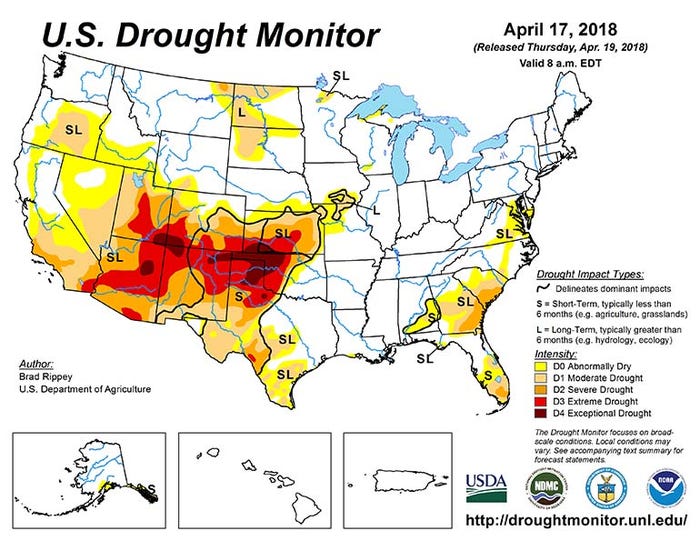
As weather watchers love to say, if you don’t like the weather, just wait a bit.
In February, Farm Futures reported on a sneaky drought that had quietly been building throughout the winter for 12 consecutive weeks to envelop more than two-thirds of the contiguous U.S.
But drought’s hold on the U.S. is nothing if not fluid, and for another 12 consecutive weeks, its footprint slowly erased until 42.8% of the country is afflicted by some level of drought by April 17, according to the latest reporting from the U.S. Drought Monitor.
Late-winter and early spring rains and snows have put a major dent in the drought in some areas. In the Midwest (defined by the U.S. Drought Monitor as Minnesota, Iowa, Wisconsin, Illinois, Michigan, Indiana, Ohio and Kentucky), it has all but disappeared, hanging onto just 7.6% of the region – mostly confined in southern Iowa and northern Missouri. Three months ago, more than 34% of the region was affected.
The High Plains (defined here as Wyoming, Colorado, North Dakota, South Dakota, Nebraska and Kansas) have also made significant recovery – although the region still has a long way to go. Three months ago, nearly 83% of the region was affected. As of April 17, that’s down to 53.4%. However, more than 20% of the region – particularly in parts of Colorado and Kansas – are battling the most two severe categories of drought, D3 (extreme) and D4 (exceptional).
Further south, Oklahoma and Texas continue to suffer under severe drought conditions. In Oklahoma, more than one-third of the state is still categorized as D3 or D4. In Texas, 13.7% of the state can say the same.
Rain is needed for crops, but it also quells the danger for wildfires. Western Oklahoma, which has received only about 1.25 inches of precipitation in the last 185+ days, knows this all too well as the area struggles to contain wildfires that have scorched more than 300,000 acres of land and threatened plenty of life, livestock and property along the way.
Drought’s fluctuations this winter and spring have also yo-yoed winter wheat prices during that time. Taking May Kansas City HRW futures as an example, those prices started 2018 in the $4.50 range, then jumped to the $5.40 range by early March, fell back in the $4.80 range a month later and have since recovered back above $5.00.
So what’s next? NOAA’s precipitation outlook for May, out earlier today, shows the probability of wetter-than-normal conditions for much of the Ohio River Valley, Mid-South and East Coast, plus a small portion of the Northern Plains that includes western South Dakota and North Dakota. Drier-than-normal conditions are probable across a big portion of the western U.S., stretching from the Pacific Northwest down to the Texas Panhandle.

For more weather information, including current conditions, forecasts and more than 20 agricultural weather maps, visit www.farmfutures.com/weather.
About the Author(s)
You May Also Like






